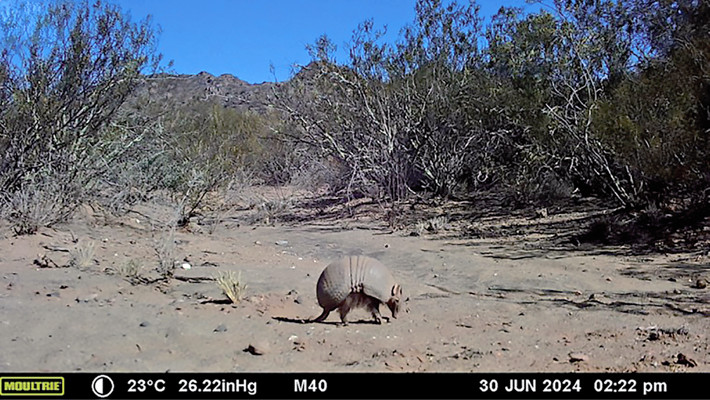Confirmation of the presence of Tolypeutes matacus (Desmarest, 1804) in a new locality in San Juan, Argentina: implications for the species' distribution limits
DOI:
https://doi.org/10.31687/SaremNMS25.1164Keywords:
Cingulata, geographical range, Monte, southern three-banded armadilloAbstract
The Cingulata order (armadillos) consists of mammals endemic to the American continent, characterized by having a dorsal shell in the form of a hard carapace and semi-fossorial habits. Using camera traps, we recorded an adult individual of the southern three-banded armadillo (Tolypeutes matacus) in a new locality in San Juan province, Argentina, expanding the altitudinal range to 1200 m a. s. l. and adding the species' presence in a new ecoregion of the province, the Monte de Sierras y Bolsones. This record increases knowledge of the species, listed as “Near Threatened”, and could be used in future conservation strategies.
References
Abba, A. M., & M. Superina. 2010. The 2009/2010 Armadillo Red List Assessment. Edentata 11:135–184. https://doi.org/10.5537/020.011.0203.
Attias, N., E. Gurarie, W. F. Fagan, & G. Mourão. 2020. Ecology and social biology of the southern three-banded armadillo (Tolypeutes matacus; Cingulata: Chlamyphoridae). Journal of Mammalogy 101:1692–1705. https://doi.org/10.1093/jmammal/gyaa117.
Attias, N., F. R. Miranda, l. M. Sena, W. M. Tomas, & G. M. Mourão. 2016. Yes, they can! Three-banded armadillos Tolypeutes sp. (Cingulata: Dasypodidae) dig their own burrows. Zoologia 33:e20160035. https://doi.org/10.1590/S1984-4689zool-20160035.
Attias, N., L. G. R. Oliveira-Santos, W. F. Fagan, & G. Mourão. 2018. Effects of air temperature on habitat selection and activity patterns of two tropical imperfect homeotherms. Animal Behaviour 140:129–140. https://doi.org/10.1016/j.anbehav.2018.04.011.
Barrientos, J., & R. L. Cuellar. 2004. Área de acción de Tolypeutes matacus por telemetría y seguimiento por hilos en Cerro Cortado del Parque Kaa-Iya. VI Congreso Internacional sobre Manejo de Fauna Silvestre en la Amazonía y Latinoamérica, Iquitos.
Barthe, M., et al. 2024. Exon capture museomics deciphers the nine-banded armadillo species complex and identifies a new species endemic to the Guiana Shield. Systematic Biology in press:syae027. https://doi.org/10.1093/sysbio/syae027.
Deem, S. L., A. J. Noss, C. V. Fiorello, A. L. Manharth, R. G. Robbins, & W. B. Karesh. 2009. Health assessment of free-ranging three-banded (Tolypeutes matacus) and nine-banded (Dasypus novemcinctus) armadillos in the Gran Chaco, Bolivia. Journal of Zoo and Wildlife Medicine 40:245–256. https://doi.org/10.1638/2007-0120.1.
Eisenberg, J. F., & K. H. Redford. 1989. Mammals of the Neotropics, Vol. 3: the Central Neotropics: Ecuador, Peru, Bolivia, Brazil. The University of Chicago Press, Chicago and London.
Ferreiro, A. M., et al. 2019. Tolypeutes matacus. Categorización 2019 de los mamíferos de Argentina según su riesgo de extinción. Lista Roja de los mamíferos de Argentina. (SAyDS–SAREM, eds.). https://doi.org/10.31687/SaremLR.19.047.
Ferreiro, A. M., J. D. Pinotti, S. Poljak, E. Soibelzon & M. B. Chiappero. 2023. Effects of Quaternary climatic oscillations over the Chacoan fauna: phylogeographic patterns in the southern three-banded armadillo Tolypeutes matacus (Cingulata: Chlamyphoridae). Zoological Journal of the Linnean Society 200:825–836. https://doi.org/10.1093/zoolinnean/zlad091.
Ferreiro, A. M., E. Soibelzon, J. D. Pinotti, S. Poljak & M. B. Chiappero. 2022. Reconstructing the distribution of Chacoan biota from current and past evidence: the case of the southern three-banded armadillo Tolypeutes matacus (Desmarest, 1804). Journal of Mammalian Evolution 29:783–795. https://doi.org/10.1007/s10914-022-09627-3.
Gaudin, T. J., & H. G. McDonald. 2008. Morphology-based investigations of the phylogenetic relationships among extant and fossil xenarthrans. The Biology of the Xenarthra (S. F. Vizcaíno & W. J. Loughry, eds). University Press of Florida, Gainesville.
González Rivas, C. J., G. N. Castillo, & I. D. Simoncelli. 2023. Contribución al conocimiento de nemátodos parásitos en mamíferos de la provincia de San Juan, Argentina. Neotropical Helminthology 17:133–143. https://doi.org/10.24039/rnh20231721653.
Haene, E. 1991. Presencia de Tolypeutes matacus (Desmarest, 1804) (Mammalia: Cingulata: Dasypodidae) en la Provincia de San Juan, República Argentina. Boletín APRONA 19:3–4.
IUCN. 2024. The IUCN Red List of Threatened Species. Version 2024-2. <https://www.iucnredlist.org>.
Loughry, W. J., M. Superina, C. M. McDonough & A. M. Abba. 2015. Research on armadillos: a review and prospectus. Journal of Mammalogy 96:635–644. https://doi.org/10.1093/jmammal/gyv005.
Noss, A., M. Superina, & A. M. Abba. 2014. Tolypeutes matacus. The IUCN Red List of Threatened Species 2014:e.T21974A47443233. https://doi.org/10.2305/IUCN.UK.2014-1.RLTS.T21974A47443233.en.
Noss, A. J. 2013. Seguimiento del corechi (Tolypeutes matacus) por medio de carreteles de hilo en el Chaco boliviano. Edentata 14:15–22. https://doi.org/10.5537/020.014.0103.
Redford, K. H. 1985. Food habits of armadillos (Xenarthra: Dasypodidae). The evolution and ecology of armadillos, sloths, and vermilinguas (G. G. Montgomery, ed.). Smithsonian Institution Press, Washington, DC.
Rossi Rotondi, E. A. 2016. Análisis del efecto de la actividad antrópica sobre el uso del hábitat a escala local del mataco (Tolypeutes matacus) en el Chaco Árido de Córdoba. Tesis de Licenciatura. Universidad Nacional de Córdoba, Córdoba, Argentina.
Secretaría de Ambiente y Desarrollo Sustentable de la Nación y Sociedad Argentina para el Estudio de los Mamíferos (eds.). 2019. Categorización 2019 de los mamíferos de Argentina según su riesgo de extinción. Lista Roja de los mamíferos de Argentina. <https://cma.sarem.org.ar>.
Silverio Reyes, M. J., M. C. Monferrán, & M. Superina. 2014. Comunicación sobre la disminución de la población de Tolypeutes matacus en el sur del Valle Central de Catamarca, Argentina. Biología en Agronomía 4:190–198.
Superina, M., N. Pagnutti, & A. M. Abba. 2014. What do we know about armadillos? An analysis of four centuries of knowledge about a group of South American mammals, with emphasis on their conservation. Mammal Review 44:69–80. https://doi.org/10.1111/mam.12010.
Superina, M., & W. J. Loughry. 2012. Life on the half-shell: consequences of a carapace in the evolution of armadillos (Xenarthra: Cingulata). Journal of Mammalian Evolution 19:217–224. https://doi.org/10.1007/s10914-011-9166-x.
Tamburini, D. M. 2016. La fauna silvestre en las estrategias de reproducción social de los campesinos del Chaco Seco de la provincia de Córdoba (Argentina). Tesis Doctoral. Universidad Nacional de Córdoba, Córdoba, Argentina.
Teta, P., et al. 2018. Lista revisada de los mamíferos de Argentina. Mastozoología Neotropical 25:163–198.
Wetzel, R. M., A. L. Gardner, K. H. Redford, & J. F. Eisenberg. 2008. Order Cingulata. Mammals of South America, Vol. 1: Marsupials, xenarthrans, shrews and bats (A. L. Gardner, ed.). University of Chicago Press, Chicago.

Downloads
Published
How to Cite
Issue
Section
License
Copyright (c) 2025 Elín A. Avellá Machado, Yamila Ontiveros, Claudia M. Campos, Flavio M. Cappa

This work is licensed under a Creative Commons Attribution-NonCommercial 4.0 International License.

